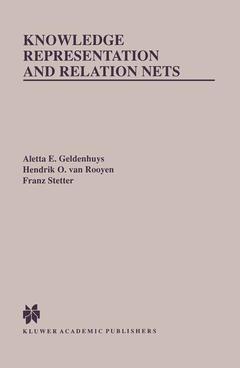Description
Knowledge Representation and Relation Nets, 1999
The Springer International Series in Engineering and Computer Science Series, Vol. 506
Authors: Geldenhuys Aletta E., van Rooyen Hendrik O., Stetter Franz
Language: English
158.24 €
In Print (Delivery period: 15 days).
Add to cart
Publication date: 10-2012
279 p. · 15.5x23.5 cm · Paperback
279 p. · 15.5x23.5 cm · Paperback
Description
/li>Contents
/li>
Knowledge Representation and Relation Nets introduces a fresh approach to knowledge representation that can be used to organize study material in a convenient, teachable and learnable form. The method extends and formalizes concept mapping by developing knowledge representation as a structure of concepts and the relationships among them. Such a formal description of analogy results in a controlled method of modeling `new' knowledge in terms of `existing' knowledge in teaching and learning situations, and its applications result in a consistent and well-organized approach to problem solving. Additionally, strategies for the presentation of study material to learners arise naturally in this representation.
While the theory of relation nets is dealt with in detail in part of this book, the reader need not master the formal mathematics in order to apply the theory to this method of knowledge representation. To assist the reader, each chapter starts with a brief summary, and the main ideas are illustrated by examples. The reader is also given an intuitive view of the formal notions used in the applications by means of diagrams, informal descriptions, and simple sets of construction rules.
Knowledge Representation and Relation Nets is an excellent source for teachers, courseware designers and researchers in knowledge representation, cognitive science, theories of learning, the psychology of education, and structural modeling.
While the theory of relation nets is dealt with in detail in part of this book, the reader need not master the formal mathematics in order to apply the theory to this method of knowledge representation. To assist the reader, each chapter starts with a brief summary, and the main ideas are illustrated by examples. The reader is also given an intuitive view of the formal notions used in the applications by means of diagrams, informal descriptions, and simple sets of construction rules.
Knowledge Representation and Relation Nets is an excellent source for teachers, courseware designers and researchers in knowledge representation, cognitive science, theories of learning, the psychology of education, and structural modeling.
Preface. Acknowledgments. Part I: Structural Modelling of Knowledge. 1. Some Approaches to Knowledge Representation. 2. A Labelled Digraph Model for Knowledge Representation. 3. Cascades, Formal Schemas, and Derivability. 4. Knowledge Structures. 5. Presentation Strategies for CRKS's. 6. Accommodations and Analogy. 7. An Example of Structural Analogy. 8. Modelling New Knowledge. 9. Models of Reasoning. 10. Potential Uses of the CRKS Model. Part II: A CRKS for a Programming Language. 11. An Example of a CRKS. Part III: Relation Nets. 12. Introduction to the Theory of Relation Nets. 13. Connectedness and Vertex Bases. 14. Vulnerability. 15. Connectivity. 16. Subnets and Factorization. Appendices: A: A Partial Model of CRKS Theory. B: List of Constructional Schemes. References. Index.
© 2024 LAVOISIER S.A.S.




